 |
 |
 |
 |
 |
 |
| |
 |
|
 |
 |
 |
  |
  |
 |
 |
 |
 |
|
 |
 |
Alessandro Mendini
|
|
* Milan [Milano], Italy, 16 August 1931 |
|
+ Milan [Milano], Italy, 18 February 2019 |
| nationality:
italian |
|
 |
|
|
|
|
|
 |
 |
 |
AWARDS |
 |
|  |
|
 |
 |
 |
|
|
 |
European Prize for Architecture
Chicago Athenaeum Museum of Architecture And Design
The European Centre for Architecture Art Design And Urban Studies |
|
 |
 |
 |
BUILDINGS |
 |
|
 |
|
 |
 |
 |
|
|
 |
|
|
  Italy [Italia]
Italy [Italia]
» Omegna |
|
|
|
|
 |
|
|
  Italy [Italia]
Italy [Italia]
» Omegna |
|
|
|
|
 |
|
|
  Italy [Italia]
Italy [Italia]
» Naples [Napoli] |
|
|
|
|
 |
|
|
|
 |
|
|
  Italy [Italia]
Italy [Italia]
» Omegna |
|
|
|
|
 |
|
|
  Italy [Italia]
Italy [Italia]
» San Donà di Piave |
|
|
|
|
 |
|
|
  Netherlands [Nederland]
Netherlands [Nederland]
» Groningen |
|
|
|
|
 |
|
|
  Germany [Deutschland]
Germany [Deutschland]
» Hanover [Hannover] |
|
|
 |
 |
 |
 |
BIBLIOGRAPHY |
 |
|
|
 |
|
 |
 |
 |
WRITINGS
BY THE ARCHITECT |
 |
|
|
 |
| Alessandro Mendini (ed.), Oggetti e Progetti/Objekte und Projekte. Alessi, Electa Mondadori, Milano 2010 |
|
|
| Loredana Parmesani (ed.), Alessandro Mendini. Gli scritti, Skira, 2004 |
|
|
| Alessandro Mendini (ed.), Tea & coffee towers, Electa, Milano 2003 |
|
|
| Alessandro Mendini, in AA.VV., Emilio Ambasz. Architettura e design. Per una riconciliazione con la natura, Electa, Milano 1995, pp. XXVIII-XXIX |
|
|
| Alessandro Mendini, "Colloquio con Zaha Hadid", Domus 650, maggio/may 1984, p. 1 (cover) |
|
|
| Alessandro Mendini, "Colloquio con Emilio Ambasz", Domus 639, maggio/may 1983, p. 1 |
|
|
| Alessandro Mendini, Architettura addio, Shakespeare and Company, 1981 |
|
|
|
 |
 |
 |
WRITINGS
ABOUT THE ARCHITECT |
 |
|
|
 |
Fulvio Irace (ed.), Io sono un drago. La vera storia di Alessandro Mendini, Elec 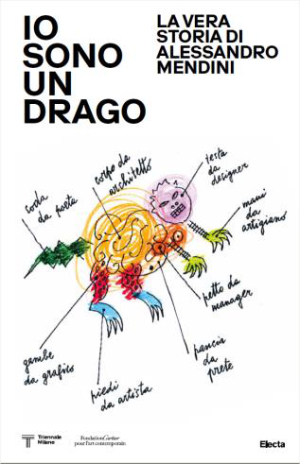 ta, Milano 2024
The volume from Electa accompanies the extensive retrospective of the work of Alessandro Mendini (1931 – 2019, Milan), promoted by Triennale Milano and Fondation Cartier pour l’Art Contemporain that will run from 13 April to 13 October 2024.
Taking its cue from one of Alessandro Mendini’s most emblematic self-portraits, Io sono un drago, the publication reviews the stages of a career that began with childhood projections and continued until the last lines traced on the drawing board.
Rejecting the logic of late Rationalism since the 1960s, Mendini blazed a trail that can only superficially be defined as eclectic. His achievement should rather be understood as an admission of the complexity of Modernity, an inextricable tangle of flows and attitudes that cannot be recognised in an unambiguous and stable identity over time.
The “Proust method” – as he called his creative approach inspired by the poetics of rêverie of his beloved writer – expressed in an iconic way his gaze on the world, his empathy with everyday things, the mystery of poetry and the leaven of irony that transformed the “banal” into surprise and revealed its hidden and human face.
His vast oeuvre ranges from design to architecture, drawing, graphics and fashion, in the titanic effort to rewrite the world, in the wake of Balla and Depero’s “Manifesto for the Futurist Reconstruction of the Universe”. |
|
|
| Alberto Fiz (ed.), Mendini. Alchimie, Mondadori Electa, Milano 2010 |
|
|
Loredana Parmesani (ed.), Alessandro Mendini. Gli scritti, Skira, Milano 2004
review: Gianni Pettena, "Mendini interdisciplinare/Interdisciplinary Mendini", Domus 876, dicembre/december 2004, "Libri/Books" pp. 112-113 |
|
|
 Peter Weiß (ed.), Alessandro Mendini. Design and Architecture, Electa architecture, 2001 Peter Weiß (ed.), Alessandro Mendini. Design and Architecture, Electa architecture, 2001 |
|
 |
 |
 |
 |
THE ARCHITECT IN CINEMA |
 |
|
|
 |
|
 |
 |
 |
| Title |
 |
|
 |
| Volevo essere Walt Disney |
|
| Directed by |
 |
|
 |
|
| Nationality |
 |
|
 |
|
| Year of production |
 |
|
 |
|
| Cast |
 |
|
 |
|
| Architect's role |
 |
|
 |
|
 |
 |
 |
 |
 |
 |
 |
INTERVIEWS |
 |
|
|
 |
|
 |
 |
 |
|
|
 |
| Juli Capella, "Intervista/Interviews. Alessandro Mendini", Domus 813, marzo/march 1999 [Mediterraneità/Mediterranean spirit], "Design" pp. 55-63 |
|
 |
 |
 |
 |
EXHIBITIONS |
 |
|
|
 |
|
 |
 |
 |
|
|
 |
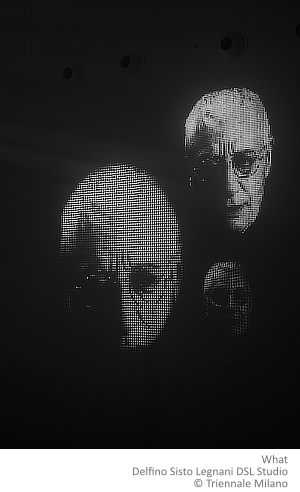 Philippe Starck, What? A homage to Alessandro Mendini by Philippe Starck, Milano [Milan] (Italy), Triennale Milano, Impluvium, 16 april /16 june 2024 Philippe Starck, What? A homage to Alessandro Mendini by Philippe Starck, Milano [Milan] (Italy), Triennale Milano, Impluvium, 16 april /16 june 2024
From April 16 to June 16, 2024, the Impluvium of Triennale Milano is the site of What? A homage to Alessandro Mendini by Philippe Starck, a site-specific installation imagined by Philippe Starck, commissioned and presented by Triennale Milano and the Fondation Cartier pour l'art contemporain. Starck is one of the most brilliant creators of our time, who shared creative and professional experiences with Alessandro Mendini.
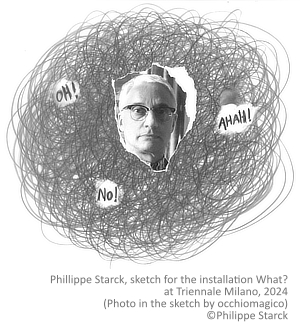 What? is an immersive installation that takes visitors into Mendini’s subconscious and his creative universe through the visionary eyes of Philippe Starck. An impressionistic journey, guided by sounds and images in constant transformation. What? is an immersive installation that takes visitors into Mendini’s subconscious and his creative universe through the visionary eyes of Philippe Starck. An impressionistic journey, guided by sounds and images in constant transformation.
“I owe a debt to Triennale and a debt to Alessandro Mendini.” – explains Philippe Starck – “As a young man in Milan, Triennale was a great revelation for me. I was absolutely fascinated by the building, which lit up my head. I liked Alessandro personally. Before being a human, he was an idea, a sensation, an osmotic vibration that I wanted to recapture through the installation, conceived as an immersive experience in Alessandro Mendini's brain.”
The French creator has invited Soundwalk Collective in his project, a collective of artists and musicians founded by Stephan Crasneanscki and internationally acclaimed for their concept albums, sound installations and live performances, often in collaboration with artists, musicians and writers, including, recently, Jean-Luc Godard, Nan Goldin and Patti Smith.
Triennale and Fondation Cartier have collaborated with Philippe Starck on several occasions, and some of his works are part of Triennale’s permanent collection and have been featured in many exhibitions. Starck has also collaborated with the Fondation Cartier since the beginning of the institution's life, participating to one of its first exhibitions, Vivre en couleur (1985). |
|
|
Fulvio Irace (ed.), Io sono un drago. La vera storia di Alessandro Mendini, Milano [Milan] (Italy), Triennale Milano, Spazio del Cubo,13 april / 13 october 2024
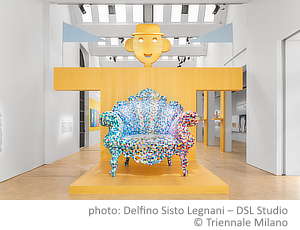 Presented in collaboration with Elisa and Fulvia Mendini – Archivio Alessandro Mendini, the retrospective is curated by Fulvio Irace with exhibition design by Pierre Charpin, who has collaborated with Mendini on several occasions. The Cubo space of Triennale displays over 400 works with different formats, materials and subjects, from many private and public collections, in particular those from: Alessandro Mendini Archive, Fondation Cartier, Triennale Milano, Groninger Museum, Vitra Design Museum, Abet Laminati Museum, Alessi and Bisazza. Presented in collaboration with Elisa and Fulvia Mendini – Archivio Alessandro Mendini, the retrospective is curated by Fulvio Irace with exhibition design by Pierre Charpin, who has collaborated with Mendini on several occasions. The Cubo space of Triennale displays over 400 works with different formats, materials and subjects, from many private and public collections, in particular those from: Alessandro Mendini Archive, Fondation Cartier, Triennale Milano, Groninger Museum, Vitra Design Museum, Abet Laminati Museum, Alessi and Bisazza.
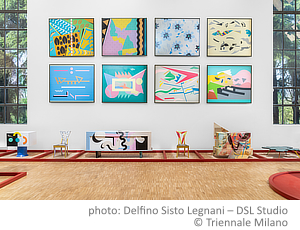 The title of the exhibition, Io sono un drago (I am a dragon), draws on one of the most emblematic self-portraits by Alessandro Mendini and is intended to emphasize the complexity of this figure in the worlds of international design, architecture, and art. The exhibition sets out to restore Mendini's gaze on the world, his empathy for everyday objects and the mystery of his artistic philosophy that can transform even the most humdrum into a surprise that reveals the magic of the everyday. The title of the exhibition, Io sono un drago (I am a dragon), draws on one of the most emblematic self-portraits by Alessandro Mendini and is intended to emphasize the complexity of this figure in the worlds of international design, architecture, and art. The exhibition sets out to restore Mendini's gaze on the world, his empathy for everyday objects and the mystery of his artistic philosophy that can transform even the most humdrum into a surprise that reveals the magic of the everyday.
The exhibition design, by Pierre Charpin, interprets the concept of the “dragon” as an accumulation of thematic nuclei that characterize the “Mendini method”: an archipelago of islands representing various moments in history and, at the same time, the threads of underground continuity that make it possible to bring a substantial continuity to the apparent diversity of his ceaseless research, based on his own human experience. As visitors enter the large room, they find themselves immersed in a unique environment, accentuated by a large axis that creates an imaginary link between the Petite Cathédrale and the Tête Géante, with the Muzio staircase in the background: a miniature piece of architecture and a big head to exemplify Mendini's work on the staircase of perception.
The exhibition itinerary is structured in six thematic nuclei: Identikit, featuring the series of self-portraits that Mendini created over the course of his whole life, using different techniques and formats; La sindrome di Gulliver (The Gulliver syndrome), with a succession of objects that are out of scale, from extra-large ones – such as the Poltrona di Proust and the Petite Cathédrale, both part of the Fondation Cartier collection – to some of the reduced-size projects created for Alessi; Architetture (Architectures), which presents the architectural works of the Mendini workshop, including the Groninger Museum, the Mediazentrum Madsack in Hanover, the three stations of the Naples Metro, and his most recent works in South Korea, from the Olympic Stadium to the Posco district in Seoul; Fragilismi, a nucleus dedicated to the research that led to the “Fragilisme” exhibition, designed by Mendini on the invitation of the Fondation Cartier: a hymn to the fragility of the earth in a world marked by war and violence; Radical Melancholy, a section dedicated to the years of radical design, of which Mendini was one of the principal theorists; and Stanze (Rooms), with three of the rooms that Mendini designed: immersive environments where references, memories, dreams and nightmares accumulate.
In the cinema hall, there is a screening of a documentary by Francesca Molteni, covering the life and works of Alessandro Mendini. In addition, the wall of the Triennale staircase landing features an oversized Mendinigrafo, while the Cuore space hosts historic publications by and about Alessandro Mendini, from the Alessandro Mendini Archive, the Éditions Fondation Cartier pour l'art contemporain and the Triennale Milano Library. Finallly, visitors to the garden can see the flag created by Mendini for the Draw me a Flag project, an 81-flag installation conceived by Christian Boltanski and realized in 2018, belonging to the collection of the Fondation Cartier pour l’art contemporain.
EXHIBITION THEMATIC NUCLEI
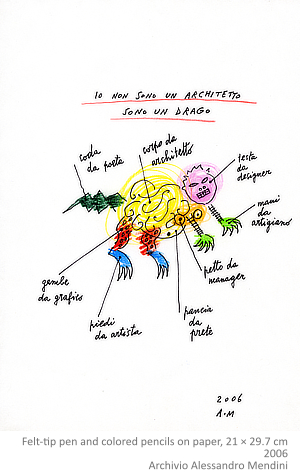 Identikit Identikit
For Mendini, self-representation is “existential exploration, vivisection of the body” through drawing: a therapeutic gymnastics, a life practice that dates back to his formative years at the Politecnico di Milano, when his vocation as an architect was beginning to be undermined by the lure of art.
In 1960, he imagined himself constrained within the contraction of a mirror, his features deformed and elongated, almost ghostly. A few years later, in 1972, his image sanctified by a self-supporting halo, a sort of relic of himself, is annotated by the acid sequence of his name: “M.A.”, “A.M2”, “A men”. The disturbing Autoritratto con Prigioniero di Mauthausen (1974) is accompanied by the vision of a Mendini crocifisso (1974), an externalization of the artist’s unhappy conscience in a world of indifference and desolation. The self-portraits of the 1980s are characterized by a newfound playfulness accompanied by an acute self- perception. Io sono un drago (2006) is an imaginative representation of his manifold creative activity as a summation of anatomical parts corresponding to specific qualities that takes the form of a mythological figure tradition- ally connoted as wild and evil.
Gulliver’s Syndrome
The result of “unbalancing gymnastics”, scale work is a tool to stress the design, because as Alice said, “Being so many different sizes in a day is very confusing!” The “giant game” (and its opposite) highlights “the loss of the unit of measurement”, but makes the body play the role of measuring the proportions. Is the Petite Cathédrale, which marks the start of a series of giants in miniature, a small piece of architecture or a large design object? Conversely, the Tête Géante serves as an ironic counterpoint to it, along with the interplay of Cavalieri di Dürer, present in all kinds of heights. The world of Lilliput is confronted with that of Brobdingnag, disorienting the observer: the extra-large Poltrona di Proust (which serves as the entrance to the exhibition) is different from the intimist dimension of the original, and this in turn is different from the ironic bibelot reduction in different materials.
Architecture
Designing is painting. This is the underlying principle of the Atelier Mendini run with his brother Francesco: “We create wandering architecture, conceptual relics of painted installations. The materials we work on are the colouring and mannerism of visual alphabets rendered abstract and autonomous.”
This did not prevent the creation of highly innovative works, such as the Groninger Museum and the three Naples Metro stations, indicative of a working method (the Designing Community) based on a multiplicity of approaches and the organic coexistence of artists. While the Dutch museum was in fact one of the first experiments in urban regeneration, the Neapolitan stations are attemptsatacupunctureinwhichthearts arecalledtotakejointresponsibility with architecture. The Galleria Mendini in Lörrach and the Mediazentrum Madsack in Hanover are experiments in redefining the urban block that hark back to Bruno Taut’s modern- ism. The entry into the new millennium espouses the well-known format of the decorated shed, as in the design for the Posco residential district in Seoul with housing units transformed into gigantic electronic circuitboards,perhapssymbolizingthecountry’smost important technological industry.
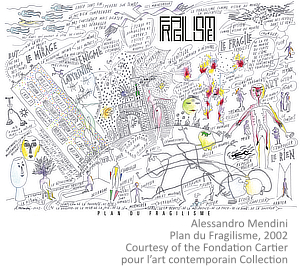 Fragilisms Fragilisms
In 2002, for his solo exhibition at the Fondation Cartier, Mendini designed the Fragilisme poster. It features a table that, like a mountain cave, represents the cosmogony of human frailty. More than a poster, it is a spiritual atlas: it does not imply a ought-to-be, but reflects who we are, with a celebration of the fragility of the earth in an aggressive world marred by wars and violence.
Recurring words—fragile, enigma, mirage, labyrinth— intertwine with the discontinuous markings of thread- like bodies resembling electrical circuits, evanescent faces, stars and waves, flames.
Older words converge there, fragments of time-worn experiences such as “soft design”, “unhappy design”, “subtle survival”, “pictorial design” and “new relig- iosity”, to compose a vision of the world as a fragile system, consistent with the eternal fragility of the human being.
Rooms
The experience of the first “home” concentrated in a room is the theme that runs through Alessandro Mend- ini’s life: the common thread that traverses the Stanza del secolo, the Stanza banale, the Stanza filosofica, the Stanza da manuale, the Chambre à souvenir, all the way through to Le mie prigioni, the extreme confession of his particular poetics of memory.
With different intonations according to different cul- tural temperaments, he has designed rooms without a view, in which quotations, memories, dreams and nightmares accumulate. Each room seeks to represent the sediments of the domestic universe: almost a photographic set using fittings that simulate a disturb- ing still life. Behind the guise of paradox, of inventive unbridledness, of the freedom of signs and colours, one senses the melancholy of reverie, congenial to the short duration of the event, of which only photography and drawing will retain traces.
The Piccola stanza con scarabeo (1996) is emblematic of the mystery of the closed room: the key dropped on the floor is the lost way out of a concentrationist universe, where decoration uninterruptedly invades furniture, floor, ceiling and walls.
Radical Melancholy
In the seventies, his years as editor of Casabella coincided with an awareness of the role of architecture at a time when political debate and social conflicts were intensifying. These were years of intense and painful reflection for Mendini, of incubation of themes that would explode into proposed images with a high expressive gradient, into acts of design terrorism expressed through counter- design objects. In 1974, the Valigia per l’ultimo viaggio and the Lassù chair marked the climax of the “unhappy conscience”, the culmination of a melancholic radicalism that found expression in the Oggetti ad uso spirituale cycle: stations for meditations on eternal thoughts, functional “owls”, “objects of normal use restored to mythological status”.
With Alchimia, the idea of re-design stems from the observation that all forms in the world already exist; to create new images, it is enough to revamp existing objects. The icon of this method remains the Poltrona di Proust, a ready-made where kitsch is divinely delivered. Linked to a performance presented in Milan on 18 September 1981, the Mobile Infinito is a celebration of the logic of teamwork, but also the manifesto of a method of designing a “catalogue” of solutions open to infinity. |
|
|
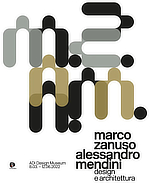 Marco Zanuso e Alessandro Mendini. Design e Architettura, Milano (Italy), ADI Design Museum, 7 march / 12 june 2022 Marco Zanuso e Alessandro Mendini. Design e Architettura, Milano (Italy), ADI Design Museum, 7 march / 12 june 2022 |
|
|
Alessandro Mendini: piccole fantasie quotidiane, Napoli (Italy), Museo Madre, 31 october 2020 / 1 february 5 april 2021
Alessandro Mendini: piccole fantasie quotidiane è il primo evento espositivo che un museo pubblico italiano, il Madre, dedica ad Alessandro Mendini (Milano 1931- 2019) dopo la sua scomparsa avvenuta nell'inverno dello scorso anno.
La mostra prodotta dalla Fondazione Donnaregina per le arti contemporanee della Regione Campania, in collaborazione con Elisa e Fulvia Mendini e l'Atelier Mendini, a cura di Gianluca Riccio e Arianna Rosica, intende celebrare una delle più importanti figure nel panorama internazionale del design e dell'architettura del secondo dopoguerra. A partire da un'inedita lettura del lavoro del grande architetto milanese, condotta attraverso la ricostruzione della fitta trama di relazioni tra design, arte e architettura, che ha caratterizzato tutta la sua ricerca, il progetto indaga scambi e reciproche influenze tra la poetica mendiniana e la cultura artistica d'avanguardia – dal dialogo con l'Arte Povera al costante riferimento al Futurismo fino agli echi della cultura Divisionista e Metafisica e al confronto critico con l'estetica della Pop Art – sia nella progettazione di oggetti industriali che nella realizzazione di opere pubbliche e installazioni ambientali, offrendo un'ampia testimonianza della poliforme sperimentazione di Mendini.
Opere, prototipi, documentazioni di performance, oggetti industriali, elementi d'arredo, disegni e bozzetti, realizzati da Mendini nel corso di oltre cinquant’anni di attività, saranno organizzati in una sequenza di stanze tematiche restituendo allo spettatore tutta la mobilità del linguaggio mendiniano, segnato da un approccio ibrido e interdisciplinare al progetto costantemente in bilico tra espressività e funzionalismo, in cui il principio dell’assemblaggio e dell'accostamento improvviso e imprevisto di materiali, misure e forme storiche tende a prevalere sul principio della sintesi.
A partire da un'ampia rilettura del periodo Radical della prima metà degli anni Settanta, in cui Mendini, direttore della rivista “Casabella”, inizia una riflessione teorica e una sperimentazione orientata a un approccio emozionale e concettuale al progetto in chiave anti-funzionalista –attraverso l'uso di materiali naturali come la paglia e la terra e il ricorso alla performance – il percorso espositivo seguirà lo sviluppo della ricerca del designer milanese, dall'esperienza di Alchimia della seconda metà degli anni Settanta e dal periodo postmoderno sino alle esperienze più mature, segnate dal recupero della tradizione e della storia e da una forte componente letteraria nella progettazione.
Intrecciando in modo poroso linguaggi differenti a cavallo tra sperimentazione concettuale e design e tra progettazione spaziale e produzione industriale, attraverso le stanze del museo Madre i principali passaggi teorici e linguistici della ricerca di Mendini saranno presentati seguendo un andamento trasversale e diacronico – dalla decorazione concepita come tema autonomo di progettazione e come narrazione intorno all'oggetto alla tensione a scavalcare gli steccati linguistici e le rigide discipline di pittura, artigianato, design e architettura, sino alla necessità di creare un dialogo costante tra l'alto e il basso, il passato e il presente, il linguaggio artistico e la cultura popolare, il pezzo unico e la produzione in serie.
A testimonianza della poliforme ricerca dell'architetto milanese, la mostra ricostruisce le diverse tappe del rapporto tra la sua ricerca e la città di Napoli, per la quale fin dagli anni Ottanta Mendini ha realizzato diversi progetti. |
|
|
| Mondo Mendini, Groningen (Netherlands), Groninger Museum, 12 october 2019 / 5 may 2020 |
|
|
| Rompete le righe! Disegno e Libertà creativa, Napoli [Naples] (Italy), AndreaNuovoHomeGallery, 10 may / 10 october 2019 |
|
|
| Noción estética y gramática visual, Puebla (México), San Pedro Museo del Arte, 14 march / 15 may 2019 |
|
|
| Alessandro Mendini. Empatie. Un viaggio da Proust a Cattelan, Aosta (Italy), Centro Saint-Bénin, 12 december 2014 / 26 april 2015 |
|
|
| Bracciodiferro, Gaetano Pesce - Alessandro Mendini, Milano, Biblioteca di Santa Maria Incoronata, 4 / 14 april 2013 |
|
|
| Peter Weiss (photo), Alessandro Mendini. Wunderkammer Design, Nürnberg, Neues Museum für Kunst und Design, 22 july / 23 october 2011 |
|
|
| Philippe Daverio (ed.), Calma e Quiete. Progetti subliminali di Alessandro Mendini, Michele De Lucchi e Angelo Micheli, Bologna, Palazzo Fava. Palazzo delle Esposizioni, 6 april/5 june 2011 |
|
|
| Alessandro Mendini. Alchimie. Dal Controdesign alle Nuove Utopie, Catanzaro, Marca (Museo delle Arti di Catanzaro), 11 aprile/25 luglio 2010 |
|
|
| Alessandro Mendini. Proust Histoire (1976 – 2010), Firenze, SACI Gallery, Studio Art Centers International, 11/20 january 2010 |
|
|
| Alessandro Mendini. Dall'infinitesimo all'infinito, Roma, Museo dell'Ara Pacis,9 april/6 september 2009 |
|
|
| All'Aperto. Pierre Charpin & Alessandro Mendini, Toulouse, Galerie Kreo, 24 may/25 july 2008 |
|
|
| Alessandro Mendini tra le arti, Vicenza, Basilica Palladiana, 27 january/25 march 2001 |
|
 |
 |
 |
 |
ADDITIONS AND DIGRESSIONS |
 |
|
|
 |
|
 |
 |
 |
| |
 |
|
Matia Bazar, Magazzini Criminali, Alessandro Mendini, Architettura Sussurrante, Ariston Records, Milan [Milano] 1983
new edition:
Industrie Discografiche Lacerba, Florence [Firenze] 2019
cover: Anti-B Design, New York
|
|
 |
 |
 |
 |
  |
 |
|
|